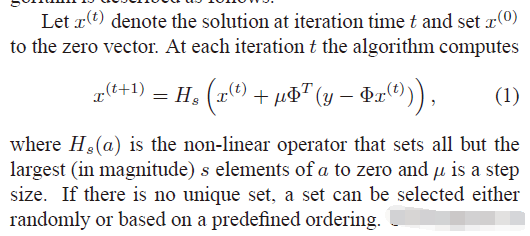压缩感知重构算法之IHT算法python实现
压缩感知重构算法之OMP算法python实现
压缩感知重构算法之CoSaMP算法python实现
压缩感知重构算法之SP算法python实现
压缩感知重构算法之IHT算法python实现
压缩感知重构算法之OLS算法python实现
压缩感知重构算法之IRLS算法python实现
IHT(iterative hard thresholding )算法是压缩感知中一种非常重要的贪婪算法,它具有算法简单的有点,且易于实现,在实际中应用较多。本文给出了IHT算法的python和matlab代码(本文给出的代码未经过优化,所以重建质量不是非常好),以及完整的仿真过程。
算法流程
python代码
要利用python实现,电脑必须安装以下程序
- python (本文用的python版本为3.5.1)
- numpy python包(本文用的版本为1.10.4)
- scipy python包(本文用的版本为0.17.0)
- pillow python包(本文用的版本为3.1.1)
#coding:utf-8
#%%%%%%%%%%%%%%%%%%%%%%%%%%%%%%%%%%%%%%%%%%%%%%%%%%%%%%%%%
# DCT基作为稀疏基,重建算法为IHT算法,图像按列进行处理
# 参考文献: Carrillo R E, Polania L F, Barner K E. Iterative hard thresholding for compressed sensing
#with partially known support[C]
#//Acoustics, Speech and Signal Processing (ICASSP),
#2011 IEEE International Conference on. IEEE, 2011: 4028-4031.
#
#%%%%%%%%%%%%%%%%%%%%%%%%%%%%%%%%%%%%%%%%%%%%%%%%%%%%%%%%%
#导入集成库
import math
# 导入所需的第三方库文件
import numpy as np #对应numpy包
from PIL import Image #对应pillow包
#读取图像,并变成numpy类型的 array
im = np.array(Image.open('lena.bmp'))#图片大小256*256
#生成高斯随机测量矩阵
sampleRate=0.7 #采样率
Phi=np.random.randn(256,256)
u, s, vh = np.linalg.svd(Phi)
Phi = u[:256*sampleRate,] #将测量矩阵正交化
#生成稀疏基DCT矩阵
mat_dct_1d=np.zeros((256,256))
v=range(256)
for k in range(0,256):
dct_1d=np.cos(np.dot(v,k*math.pi/256))
if k>0:
dct_1d=dct_1d-np.mean(dct_1d)
mat_dct_1d[:,k]=dct_1d/np.linalg.norm(dct_1d)
#随机测量
img_cs_1d=np.dot(Phi,im)
#IHT算法函数
def cs_IHT(y,D):
K=math.floor(y.shape[0]/3) #稀疏度
result_temp=np.zeros((256)) #初始化重建信号
u=0.5 #影响因子
result=result_temp
for j in range(K): #迭代次数
x_increase=np.dot(D.T,(y-np.dot(D,result_temp))) #x=D*(y-D*y0)
result=result_temp+np.dot(x_increase,u) # x(t+1)=x(t)+D*(y-D*y0)
temp=np.fabs(result)
pos=temp.argsort()
pos=pos[::-1]#反向,得到前面L个大的位置
result[pos[K:]]=0
result_temp=result
return result
#重建
sparse_rec_1d=np.zeros((256,256)) # 初始化稀疏系数矩阵
Theta_1d=np.dot(Phi,mat_dct_1d) #测量矩阵乘上基矩阵
for i in range(256):
print('正在重建第',i,'列。。。')
column_rec=cs_IHT(img_cs_1d[:,i],Theta_1d) #利用IHT算法计算稀疏系数
sparse_rec_1d[:,i]=column_rec;
img_rec=np.dot(mat_dct_1d,sparse_rec_1d) #稀疏系数乘上基矩阵
#显示重建后的图片
image2=Image.fromarray(img_rec)
image2.show()
matlab代码
%代码在matlab2010b测试通过
function Demo_CS_IHT()
%%%%%%%%%%%%%%%%%%%%%%%%%%%%%%%%%%%%%%%%%%%%%%%%%%%%%%%%%%%%%%%%%%%%%%%%%%%
% the DCT basis is selected as the sparse representation dictionary
% instead of seting the whole image as a vector, I process the image in the
% fashion of column-by-column, so as to reduce the complexity.
% Author: Chengfu Huo, roy@mail.ustc.edu.cn, http://home.ustc.edu.cn/~roy
% Reference: T. Blumensath and M. Davies, “Iterative Hard Thresholding for
% Compressed Sensing,” 2008.
%%%%%%%%%%%%%%%%%%%%%%%%%%%%%%%%%%%%%%%%%%%%%%%%%%%%%%%%%%%%%%%%%%%%%%%%%%%
%------------ read in the image --------------
img=imread('lena.bmp'); % 256*256大小
img=double(img);
[height,width]=size(img);
sampleRate=0.7; %采样率
%------------ form the measurement matrix and base matrix ---------------
%Phi=randn(floor(height/3),width); % only keep one third of the original data
%Phi = Phi./repmat(sqrt(sum(Phi.^2,1)),[floor(height/3),1]); % normalize each column
Phi = orth(rand(256, 256));
Phi=Phi(1:256*sampleRate, :);
mat_dct_1d=zeros(256,256); % building the DCT basis (corresponding to each column)
for k=0:1:255
dct_1d=cos([0:1:255]'*k*pi/256);
if k>0
dct_1d=dct_1d-mean(dct_1d);
end;
mat_dct_1d(:,k+1)=dct_1d/norm(dct_1d);
end
%--------- projection ---------
img_cs_1d=Phi*img; % treat each column as a independent signal
%-------- recover using omp ------------
sparse_rec_1d=zeros(height,width);
Theta_1d=Phi*mat_dct_1d;
for i=1:width
column_rec=cs_iht(img_cs_1d(:,i),Theta_1d,height);
sparse_rec_1d(:,i)=column_rec'; % sparse representation
end
img_rec_1d=mat_dct_1d*sparse_rec_1d; % inverse transform
%------------ show the results --------------------
figure(1)
subplot(2,2,1),imagesc(img),title('original image')
subplot(2,2,2),imagesc(Phi),title('measurement mat')
subplot(2,2,3),imagesc(mat_dct_1d),title('1d dct mat')
psnr = 20*log10(255/sqrt(mean((img(:)-img_rec_1d(:)).^2)));
subplot(2,2,4),imshow(uint8(img_rec_1d));
title(strcat('PSNR=',num2str(psnr),'dB'));
disp('over')
%************************************************************************%
function hat_x=cs_iht(y,T_Mat,m)
% y=T_Mat*x, T_Mat is n-by-m
% y - measurements
% T_Mat - combination of random matrix and sparse representation basis
% m - size of the original signal
% the sparsity is length(y)/4
hat_x_tp=zeros(m,1); % initialization with the size of original
s=floor(length(y)/4); % sparsity
u=0.5; % impact factor
% T_Mat=T_Mat/sqrt(sum(sum(T_Mat.^2))); % normalizae the whole matrix
for times=1:s
x_increase=T_Mat'*(y-T_Mat*hat_x_tp);
hat_x=hat_x_tp+u*x_increase;
[val,pos]=sort((hat_x),'descend'); % why? worse performance with abs()
hat_x(pos(s+1:end))=0; % thresholding, keeping the larges s elements
hat_x_tp=hat_x; % update
end
参考文章
1、Carrillo R E, Polania L F, Barner K E. Iterative hard thresholding for compressed sensing with partially known support[C]//Acoustics, Speech and Signal Processing (ICASSP), 2011 IEEE International Conference on. IEEE, 2011: 4028-4031.
欢迎python爱好者加入:学习交流群 667279387
压缩感知重构算法之IHT算法python实现的更多相关文章
- 压缩感知重构算法之IRLS算法python实现
压缩感知重构算法之OMP算法python实现 压缩感知重构算法之CoSaMP算法python实现 压缩感知重构算法之SP算法python实现 压缩感知重构算法之IHT算法python实现 压缩感知重构 ...
- 压缩感知重构算法之OLS算法python实现
压缩感知重构算法之OMP算法python实现 压缩感知重构算法之CoSaMP算法python实现 压缩感知重构算法之SP算法python实现 压缩感知重构算法之IHT算法python实现 压缩感知重构 ...
- 压缩感知重构算法之CoSaMP算法python实现
压缩感知重构算法之OMP算法python实现 压缩感知重构算法之CoSaMP算法python实现 压缩感知重构算法之SP算法python实现 压缩感知重构算法之IHT算法python实现 压缩感知重构 ...
- 压缩感知重构算法之SP算法python实现
压缩感知重构算法之OMP算法python实现 压缩感知重构算法之CoSaMP算法python实现 压缩感知重构算法之SP算法python实现 压缩感知重构算法之IHT算法python实现 压缩感知重构 ...
- 压缩感知重构算法之OMP算法python实现
压缩感知重构算法之OMP算法python实现 压缩感知重构算法之CoSaMP算法python实现 压缩感知重构算法之SP算法python实现 压缩感知重构算法之IHT算法python实现 压缩感知重构 ...
- 浅谈压缩感知(三十一):压缩感知重构算法之定点连续法FPC
主要内容: FPC的算法流程 FPC的MATLAB实现 一维信号的实验与结果 基于凸优化的重构算法 基于凸优化的压缩感知重构算法. 约束的凸优化问题: 去约束的凸优化问题: 在压缩感知中,J函数和H函 ...
- 浅谈压缩感知(三十):压缩感知重构算法之L1最小二乘
主要内容: l1_ls的算法流程 l1_ls的MATLAB实现 一维信号的实验与结果 前言 前面所介绍的算法都是在匹配追踪算法MP基础上延伸的贪心算法,从本节开始,介绍基于凸优化的压缩感知重构算法. ...
- 浅谈压缩感知(二十八):压缩感知重构算法之广义正交匹配追踪(gOMP)
主要内容: gOMP的算法流程 gOMP的MATLAB实现 一维信号的实验与结果 稀疏度K与重构成功概率关系的实验与结果 一.gOMP的算法流程 广义正交匹配追踪(Generalized OMP, g ...
- 浅谈压缩感知(二十六):压缩感知重构算法之分段弱正交匹配追踪(SWOMP)
主要内容: SWOMP的算法流程 SWOMP的MATLAB实现 一维信号的实验与结果 门限参数a.测量数M与重构成功概率关系的实验与结果 SWOMP与StOMP性能比较 一.SWOMP的算法流程 分段 ...
随机推荐
- linux 打包 | autoconf 使用方法
面试题 嵌入式 0x10道题目 宏定义 #define 宏体 宏体 (大写) #define SECOND_OF_YEAR (365*24*3600)UL 可移植性 数据声明 一个存有10个指针的数组 ...
- Java基础 ArrayList源码分析 JDK1.8
一.概述 本篇文章记录通过阅读JDK1.8 ArrayList源码,结合自身理解分析其实现原理. ArrayList容器类的使用频率十分频繁,它具有以下特性: 其本质是一个数组,因此它是有序集合 通过 ...
- 本地存储localstorage
小小插件,封装了一个存取删 <script type="text/javascript"> /* *getItem(name) * *setItem(name,valu ...
- SqlServer2005 查询 第六讲 null
今天们来讲sql命令中的这个null参数 null null: 可以理解成[没有值,空值]的意思 注意以下几点 --1.零和null是不一样的,null表示空值,而零表示的一个确定的值 --2.nul ...
- 微擎 pdo_fetchall() 函数
微擎 pdo_fetchall() 函数 注意点: 该函数内部直接执行原生 SQL 语句 如果在传递表名的时候使用了 tablename .则不加 ims_ 前缀 参数的传递通过 :param 的形式 ...
- nyoj 64-鸡兔同笼 (解二元一次方程)
64-鸡兔同笼 内存限制:64MB 时间限制:3000ms Special Judge: No accepted:26 submit:58 题目描述: 已知鸡和兔的总数量为n,总腿数为m.输入n和m, ...
- nyoj 399-整除个数 (整除)
399-整除个数 内存限制:64MB 时间限制:3000ms 特判: No 通过数:9 提交数:18 难度:1 题目描述: 1.2.3… …n这n(0<n<=1000000000)个数中有 ...
- 力扣(LeetCode)两整数之和 个人题解
不使用运算符 + 和 - ,计算两整数 a .b 之和. 示例 1: 输入: a = 1, b = 2 输出: 3 示例 2: 输入: a = -2, b = ...
- TCP/IP网络基础知识
TCP/IP是一组用于实现网络互联的通信协议,通常称为TCP/IP协议族.包括TCP.IP.UDP.ICMP.RIP.TELNETFTP.SMTP.ARP.TFTP等. 一.TCP/IP模型将协议分为 ...
- Ubuntu 16.04 更改apt源
1 修改apt源配置文件,把/etc/apt/sources.list替换为以下内容: sudo gedit /etc/apt/sources.list deb http://mirrors.aliy ...

